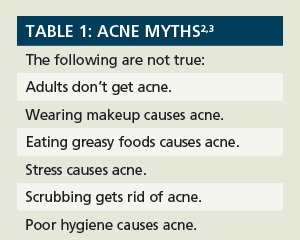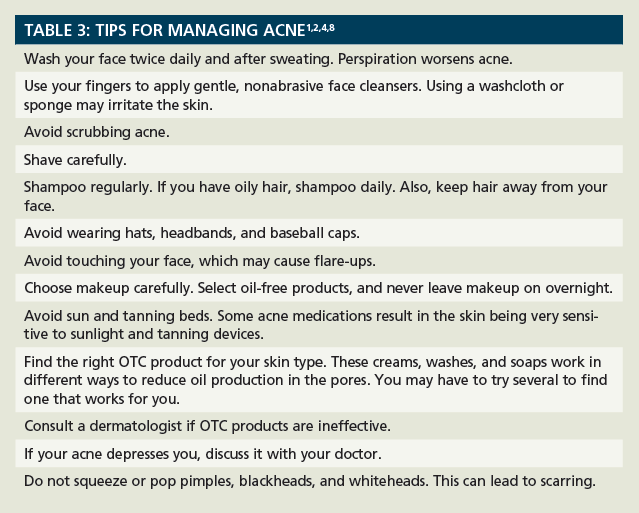Article
Acne: More than a Cosmetic Problem
Author(s):
People of all ages can develop acne, but many treatments are available.
People of all ages can develop acne, but many treatments are available.
What Causes Acne?
Your skin is covered with many tiny holes, commonly referred to as hair follicles or pores, which contain oil glands that help to keep skin and hair moisturized. During puberty, hormones can cause the skin to make too much oil, resulting in clogged pores, also known as pimples. If the top of a pimple is dark, it’s called a blackhead; if the top is white, it’s called a whitehead.
Acne symptoms include redness around pimples and small red bumps. If a clogged pore breaks open, additional swelling and red bumps can occur; acne that is deep in the skin can be especially painful.1,2 Most pimples occur on the face, but can also appear on the neck, back, chest, and shoulders. Acne and acne scars often result in depression and stress.1

Several factors can trigger acne. As previously mentioned, hormonal changes in adolescence increase the skin’s oil content. Likewise, high humidity, sweat, and stress also aggravate acne. Certain medications can contribute. Additionally, some scientists believe genetics plays a role: if a parent had acne as a teenager, his or her children are likely to have acne.2 Table 1 lists common acne myths.2,3
People of all ages, including babies and elders, can develop acne. Even people in their 30s, 40s, and 50s can develop acne.2,3 Up to 80% of people between 11 and 30 years of age have acne outbreaks,4 with 27% having severe acne, often leading to scaring.5 During adolescence, acne is more common in boys; in adults, acne is more common in women. By 40 years of age, 5% of women and men still have acne.5

Acne and Diet
Diet, as a cause of acne, has been controversial. Chocolate, pizza, and nuts do not appear to cause acne, while there is some evidence that diets high in refined sugars and dairy products may be related to acne. There is a stronger connection between skim milk and acne compared with other dairy products: people who drink 2 glasses of skim milk daily have a 44% greater chance of developing acne. White bread, rice, potatoes, and pasta may likewise play a role.6,7

Treatment
Treatments focus on 4 goals:
- Heal existing acne.
- Prevent new lesions from forming.
- Prevent scarring.
- Minimize psychological stress and embarrassment.
Most dermatologists use a combination of treatments that can be expensive and require multiple sessions before results are noticeable. Even with treatment, there is no guarantee that a person will be acnefree. Table 2 lists several medications used to treat acne.1,5 Table 3 lists tips for managing acne.1,2,4,8 If OTC products do not get the desired result, dermatologists can prescribe stronger medications. Most of these medications help break down blackheads and whiteheads by unclogging skin pores. All medicines have side effects, and your doctor or pharmacist will discuss these with you.4
Acne Scars
Acne scarring ranges from mild to severe, the latter being associated with deep tissue scars. Laser skin resurfacing, dermabrasion, chemical peels, and the use of fillers are 4 procedures used to treat acne scars. Laser skin resurfacing removes skin layer by layer, with precision, so that skin cells formed during healing give the skin a tighter, younger-looking surface. Dermabrasion, also called sanding, removes layers of skin, as well. Chemical peels involve applying a chemical solution to the skin to make it “blister” and eventually peel off; the new skin revealed is usually smoother than the old skin. Fillers, which are injected, “plump” up scars and bring them closer to the surface, thereby making them less noticeable. The effects of fillers last between 6 and 18 months.9 Acne surgery is another treatment option. The surgery involves lifting the scar to make it less noticeable. Over time, some acne scars fade.
Your doctor may use medications to prevent scarring. Bellafill was recently approved to treat acne scars. Isotretinoin is also very effective in treating and preventing scars; however, because isotretinoin can cause birth defects, it is not used in pregnant women.4,10
Final Thought
Acne, left untreated, can lead to scars, depression, and stress. Early treatment is critical to obtain the best results and minimize or prevent scarring.
Dr. Zanni is a psychologist and health-system consultant based in Alexandria, Virginia.
References
- Acne. US National Library of Medicine website. www.nlm.nih.gov/medlineplus/ency/article/000873.htm. Accessed January 7, 2015.
- Under the microscope. Centers for Disease Control and Prevention website. www.cdc.gov/bam/nutrition/microscope.html. Accessed March 25, 2015.
- 10 myths and facts about adult acne. WebMD website. www.webmd.com/skin-problems-and-treatments/acne/features/10-myths-and-facts-about-adult-acne. Accessed January 7, 2015.
- Questions and answers about acne. National Institute of Arthritis and Musculoskeletal and Skin Diseases website. www.niams.nih.gov/Health_Info/Acne/default.asp. Accessed January 7, 2015.
- Jaggi R. Acne vulgaris. Medscape website. http://emedicine.medscape.com/article/1069804-overview. Accessed January 7, 2015.
- Katta R, Desai SP. Diet and dermatology: the role of dietary intervention in skin disease. J Clin Aesthet Dermatol. 2014;7(7):46-51.
- Acne: role of food remains controversial. American Academy of Dermatology website. www.aad.org/dw/monthly/2011/september/diet-and-acne. Accessed January 7, 2015.
- Acne: tips for managing. American Academy of Dermatology website. www.aad.org/dermatology-a-to-z/diseases-and-treatments/a---d/acne/tips. Accessed January 7, 2015.
- Acne scars: treatment and outcome. American Academy of Dermatology website. www.aad.org/dermatology-a-to-z/diseases-and-treatments/a---d/acne-scars/treatment-and-outcome. Accessed January 7, 2015.
- Marotta R. FDA approves new acne scar treatment. Pharmacy Times website. www.pharmacytimes.com/product-news/FDA-Approves-New-Acne-Scar-Treatment. Accessed January 7, 2015.
Newsletter
Stay informed on drug updates, treatment guidelines, and pharmacy practice trends—subscribe to Pharmacy Times for weekly clinical insights.





